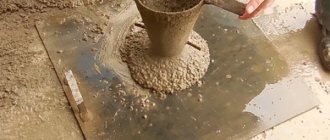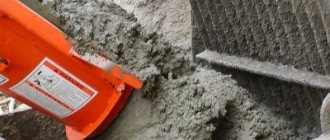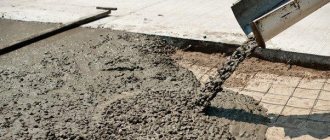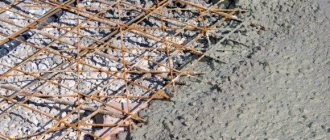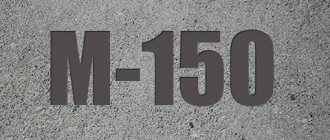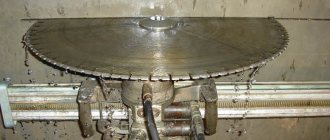Water is an essential component of any concrete. Certain requirements are determined for it - low acidity, absence of salts and organic additives such as soil, fats, petroleum products, etc. But for high-quality concrete, an important point is the water-cement ratio - the amount of liquid and cement that needs to be added to obtain a specific volume of solution.
What is the water-cement ratio for concrete and why it needs to be taken into account
The water-cement ratio is the ratio of the volume of water to the mass of cement in a concrete batch. The impermeability of concrete will directly depend on the value of this parameter. In construction, the water-cement ratio is calculated using the formula w/c = mass of water/mass of cement, usually equal to 0.25, which in proportions is 1:4.
Some add water in a ratio of 0.35-0.6 to make working with the solution easier, which affects the strength of the masonry or monolith. Therefore, if there is a need to make the solution more fluid, but maintain strength, you can use special plasticizers.
The ratio of sand, water and cement affects the resistance of concrete to compressive forces. The more water in the mixture, the less strong the concrete will be, the more permeable and less dense, which will correspondingly affect the strength and durability of the entire building or structure. Excess water that has not reacted will evaporate during the concrete hardening process and can cause the appearance of cracks, voids, and other defects.
Concrete hardens by undergoing a chemical reaction of water with cement and sand - a hydration reaction, accompanied by the release of heat (heat of hydration). To obtain a high-quality solution, take 250 milliliters of water for each kg of cement.
Conclusion
The correct water-cement ratio is one of the main conditions for obtaining high-quality concrete. At the same time, the well-known rule that only 25% of water by weight is required to hydrate cement is not applicable in practice. This is due to the fact that some excess water must remain to ensure the mobility of the solution. A small amount of water negatively affects the strength of structures and monoliths after complete setting and makes high-quality compaction of the mixture impossible. Therefore, when producing concrete of various grades, it is necessary to adhere to technological requirements.
Excess moisture in the mortar also leads to a decrease in its quality. If the liquid is not properly bound, then the components of the solution separate in it relative to its own density. As a result, instead of a monolith, you get a “layer cake” that does not meet any technical requirements. The main sign of excess water is its release on the surface of the laid monolith. Therefore, in cases where additional workability of the solution is required, for example, when filling formwork with dense reinforcement, it is better to use plasticizers. They will give the solution additional mobility without adding excess water. It is imperative to take into account the fact that when laying a concrete mixture at temperatures below zero, the W/C should be as low as possible so that most of the water participates in the hydration of the binder with the release of heat.
In private construction, to obtain the required water-cement ratio, it is advisable to make a test batch. To do this, add 3 parts of sand to one part of cement, slightly moisten the resulting material and add 5 parts of crushed stone. After this, water is added in small portions from a measuring cup (to know its volume) to obtain the required mobility of the solution. After this, the lump of concrete mortar is laid on a flat surface - if it holds its shape, the water-cement ratio is optimal; if it spreads, there is a lot of water; when the lump falls apart and delaminates, additional water must be added to it.
Why is it important?
The water-cement ratio is understood as the ratio of the mass of water to the mass of cement required to prepare the working mixture. If more liquid is added to concrete than necessary, its quality deteriorates sharply; the performance of M400 concrete can correspond to the M200 grade. After laying, the monolith delaminates, and its strength decreases several times. However, cement hydration is impossible without water, so it must be present. The requirements for the water-cement ratio of the concrete mixture are set out in GOST for each specific type of cement. The reduction in concrete strength depending on the grade and W/C ratio is presented in the graph.
The same process can be seen in the table:
The nonlinearity of the characteristics is due to the fact that the chemical process of concrete hardening is quite complex. For example, moisture that does not participate in hydration remains unbound, resulting in capillaries and pores remaining in the monolith, reducing its density and strength. At the same time, the pores towards the surface of the concrete expand, so it begins to crumble due to a decrease in water permeability. If moisture remains in the thickness of concrete until frost, it will inevitably freeze and begin to tear structures from the inside, reducing the strength characteristics. In this case, excess water affects the mobility of the solution, which should also be optimal. The dependence of the cone height on the water-cement mixture and the proportions of other components can be seen in the following table:
This means that a correctly selected water-cement ratio is a guarantee that the concrete will meet the stated characteristics.
Calculation of the amount of water
According to the generally accepted rule, for complete hydration of Portland cement it will require only 25% of its mass of water. But in practice it is impossible to use such a mixture, since it will be too hard, so more water will be required to obtain sufficient plasticity. To obtain a plastic, easy-to-lay solution, the water-cement ratio for concrete must be in the range from 0.4 to 0.75. If the value is lower, its mobility will be too low and cavities may remain during laying; if the value exceeds the maximum, the cement will delaminate and its strength will sharply decrease, especially for high-grade concrete.
The properties of concrete depend on the W/C ratio. If structures are operated in difficult conditions without additional waterproofing, the water-cement ratio should not exceed 0.4; such concrete is used, for example, for the production of paving slabs. For pouring foundations, greater mobility of the mixture is required, so an upper limit of 0.75 is allowed. If a concrete monolith or structure requires increased frost resistance, W/C should not exceed 0.5.
To produce the concrete mixture, high activity Portland cement of the M400 or M500 grades is used. The ratio of water to cement, depending on its type, brand or class of concrete, can be determined from the table:
| Concrete class (grade) | PC 400 | PC 500 |
| V 7.5 (M100) | 1,3 | — |
| V 12.5 (M150) | 0,85 | — |
| B 15 (M200) | 0,69 | 0,79 |
| B 20 (M 250) | 0,57 | 0,64 |
| V 22.5 (M300) | 0,53 | 0,61 |
| B 25 (M300-M350) | 0,5 | 0,58 |
| B 27.5 (M350) | 0,48 | 0,55 |
Obviously, the higher the grade of concrete, the greater the consumption of cement is required with a smaller amount of liquid; the required mobility in this case is achieved through the use of plasticizers - additives that increase the mobility of concrete without adding water. For example, to produce M300 concrete per 100 kg of cement, you will need 100·0.53=53 liters of water for PC 400 or 100·0.61=61 liters for PC 500.
Mixture labeling
GOST requirements regulate the use of alphanumeric markings of concrete. This one looks like this: Concrete M400 B30/P4/F300/W10
- The letter "M" means the brand of concrete mixture.
- The letter “K” is the class of the solution.
- “P” is an indicator of mobility.
- “F” – frost resistance.
- “W” – waterproofness of the concrete solution.
The process of producing a solution, in accordance with the standards established by law, is a labor-intensive, complex procedure that requires skills and many years of experience. You should not trust the production of concrete to artisanal companies. Such a product can affect the strength of the structure, leading to cracking or complete destruction of the structure.
In addition, in the process of creating concrete mixtures, professional, high-tech equipment is used, which allows us to produce impeccable quality materials. Trust only trusted manufacturers and suppliers of concrete.
GOST for heavy concrete - terminology used
The standard uses special terminology and applies a differentiated approach to different concrete compositions. He divides them into the following types:
- heavy. They are characterized by a high-density structure and specific gravity in the range of 2–2.5 t/m3. They are made on the basis of cement and coarse or fine filler with increased density;
- fine-grained. The average density of the fine-grained monolith, as well as the structure of the material, correspond to heavy compositions. The main difference is the use of fine-grained filler, which is mixed with Portland cement during mixing.
Each type of concrete solution is made according to a specific recipe and, after hardening, forms an artificial stone.
The strength of concrete increases as a result of physical and chemical processes of interaction between cement and water, which normally take place in warm and humid conditions.
Test batch
Scheme for preparing concrete: 1 - Mixing the dry mixture with water, 2 - Mixing on plywood, 3 - Concrete mixer, 4 - Hose for adding water, 5 - Cement, 6 - Sand.
It is assumed that all work is done manually using a shovel or trowel (in this case, the portion is minimal, but if the attempt fails, you don’t mind throwing it away). When the ratio is more accurately determined, it is wiser to use a concrete mixer, the use of which significantly affects the quality and speed of mixing while reducing physical activity.
What is water cement ratio
The picture posted at the beginning of this article shows such an indicator as B/C. What it is? This water-cement ratio is the most important indicator in concrete production. That is, the derivative of dividing the mass of water by the mass of cement. The optimal value would be 0.4. If this indicator is lower, then the lack of water will lead to the fact that not all cement particles will enter into a hydration reaction and part of it will be wasted, which will lead to a loss of strength. If the W/C exceeds 0.4, then excess water will also lead to a decrease in the strength of the final structure.
It is important to correlate the W/C ratio with the workability of the mixture. This is when the concrete mixture completely fills the formwork structure without creating voids.
A hard mixture will make concreting difficult, but it is not necessary to add water to improve these properties.
For this purpose, there are plasticizing and even superplasticizing additives. In such cases, the W/C level remains at the desired level and workability does not suffer. Depending on the concreting work performed, the workability of the supplied concrete is determined, which is established by the manufacturer. It should be noted that for a mortar mixture, such an indicator as mobility is used.
Calculation of material consumption per batch of concrete mixer
Depending on the volume of concrete work on construction sites, gravity-type concrete mixers with a capacity of 60 to 3000 liters are mainly used. To calculate the consumption of materials for one batch, we will take a concrete mixer with a mixing drum capacity (Vb) of 1200 liters. The production consumption of materials per 1 m3 of concrete is as follows:
Tspr - 312 kg, Vpr - 153 l, Ppr - 612 kg, Shch - 1296 kg.
The volumetric weight of wet sand and crushed stone is taken to be 1.6 and 1.495 kg/l, respectively, the volumetric weight of cement is 1.3 kg/l, crushed stone is used in two fractions: 40% crushed stone with a particle size of 10–20 mm and 60% crushed stone with a particle size of 20–40 mm. Let's calculate the consumption of materials for one batch. To do this, we determine the yield coefficient of the concrete mixture:
Water cement ratio
For the normal course of cement hydration processes and giving the solution the necessary mobility, it is necessary to maintain the optimal water-cement ratio (water demand). The water requirement of cement is the minimum amount of water that ensures the production of cement paste of normal thickness. Normal density is the consistency at which the Tetmeyer pestle sinks into the product to the depth established by the standards.
Portland cement has the minimum water requirement - 24-28%. This indicator can be reduced while maintaining the required plasticity of the mixture or solution by introducing special additives - plasticizers. The water requirement of pozzolanic cements in the presence of additives of sedimentary origin is 35-40%.
Composition of concrete M100
Like other brands of heavy concrete, M100 consists of: granite or crushed gravel (filler), quarry or river sand, Portland cement CEM I 32.5N PC (M400) or CEM I 42.5N PC (M500) and clean fresh water. Due to the limited scope of application, additives are not added to this brand of concrete.
For lightly loaded structures (blind area, garden path, preparatory work) erected on private farmsteads, it is allowed to use slag formed by burning coal, broken bricks and other construction waste as filler.
Other physical and mechanical properties
Shrinkage:
- determines the reduction in the linear dimensions of concrete when it matures in the open air;
- the degree of shrinkage varies from 0.30 to 1.00 mm/m;
- the maximum reduction is observed at the beginning of hardening - in the first 24 hours 70% of the total is achieved;
- if the working solution contains incorrect proportions of water and cement, shrinkage increases.
Fire resistance:
- determines the ability of a material to maintain strength against short-term exposure to high temperatures;
- reinforced concrete is heated to a small depth, which is due to its low thermal conductivity;
- with prolonged exposure to fire, irreversible chemical changes develop in the base and it loses strength;
- For the construction of furnaces and fireboxes, heat-resistant reinforced concrete with special fillers and alumina cement is used.
In the case of self-preparing solutions, ready-mixed concrete is purchased. The average level of costs was as follows. For m³ of material of the M100 brand you will have to pay about 2100 rubles, M300 - 2890 rubles, M400 - 3800 rubles .
The compliance of the concrete grade and its class according to GOST is described in the video:
Material requirements
Properly selected components in terms of quality and fractions to obtain durable hard concrete grade 75 is half the success. What characteristics of cement and fillers should I pay attention to?
Cement, the quality of which is directly related to the strength of hardened concrete, for reasons of saving on its cost, M200 or M300 is taken. The use of higher quality cements will be much more expensive; this difference cannot be covered by slightly reducing the percentage of cement to fillers. The strength characteristics of the specified grades of cement, subject to the water-cement ratio for concrete, make it possible to obtain high-quality concrete of at least 75 grade at your own construction site.
Table of concrete grades and their main characteristics.
It should be noted that the brand of concrete and the brand of cement that is part of the mixture are not the same thing. The ratio looks something like this: to produce concrete, for example, grade 75, you will need M200 or M300 cement, that is, the grade of cement taken should be 2.5-3 times higher. When buying cement, you should pay attention to the date of its release, since as the shelf life increases, the quality decreases, and after 1.5 years of storage, even under ideal conditions, cement can only be used for arranging garden paths. At the household level, you can check the relative quality of cement. To do this, cement is poured onto an open dry palm and the hand is clenched into a fist. High-quality material “flows” through your fingers with virtually no residue.
There are also requirements for sand. It is preferable to use fine-grained (the size of an individual grain of sand is up to 1.25 mm). It allows you to obtain a mixture in which the air gaps, which reduce the rigidity of concrete, are minimized. The sand must be free of dust and foreign inclusions of organic origin.
The size of gravel or crushed stone should not exceed 1/3 of the width of the formwork.
Under no circumstances should crushed limestone be used for rigid concrete.
If reinforcement is being used, the particle size cannot exceed 1/4 of the smallest size of the structure being cast and 3/4 of the clearance between the reinforcement bars. Failure to comply with the specified proportions can lead to the formation of voids in the finished concrete product, which will inevitably reduce the strength indicators.
Corrosion resistance
The process of concrete corrosion refers to the destruction of cement, which is accompanied by a decrease in indicators such as water resistance. At the same time, the coefficient of adhesion to the reinforcement decreases, which leads to a decrease in strength. To prevent damage due to corrosion, various additives are used in cements that form acid-resistant, pozzolanic and aluminous mixtures. In addition, the technology of treating the concrete surface with special solutions in the form of sodium silicofluoride, liquid glass is often used, and work is carried out on tiling with ceramic-based tiles.
Determination of mobility of concrete mixture
The choice of the method of their molding largely depends on the design features of the products, and this, in turn, imposes corresponding requirements on the consistency of the concrete mixture in terms of its mobility and workability.
Concrete mixtures can be flexible or rigid. Movable mixtures, when laid, easily fill the mold and are compacted in it under the influence of their own gravity. Rigid mixtures for the above operations require the application of sometimes significant external forces. Regardless of which of these groups the concrete mixture belongs to, each of them is characterized by a certain degree of mobility under production conditions. The mobility of a concrete mixture is determined by the amount of settlement of a standard cone molded from this mixture (see figure).
To determine the settlement of the cone, you will need an average sample of the concrete mixture, a wooden or metal platform, a cone shape, a rod for joining the mixture, a steel ruler at least 70 cm long, a steel ruler with divisions 20-50 cm long, and a trowel.
Progress. On a wooden platform sheathed with sheet steel of thickness
25 mm, 70x70 cm in size, install a metal mold in the form of a truncated straight cone 30 cm high, with a lower base diameter of 20 cm and an upper base of 10 cm. The inner surface of the mold and the platform on which it is installed are moistened with water. Then, pressing the form to the platform (stepping on the pedals), the concrete mixture is placed into it in three steps in equal parts. Each portion of the concrete mixture in the mold is compacted by 25-fold baying with a smooth steel rod with a diameter of 16 mm and a length of 650 mm. With each bayonet, the rod must penetrate the entire thickness of the concrete mixture.
After compaction, the excess concrete mixture is cut off flush with the upper edges of the form, smoothing the surface of the mixture with a trowel. The mold is then slowly lifted strictly vertically and placed next to the cone formed from the mixture. A steel ruler 70 cm long is placed on the edge of the cone along its diameter so that the free end of the ruler passes through the center of the cone made of concrete mixture. The distance between the surface of the concrete mixture and the edge of the ruler is measured with another ruler with divisions accurate to 0.5 cm. The measurement result characterizes the amount of cone settlement. As a rule, the determination for the same mixture is repeated twice. The result of two parallel measurements should not differ by more than 2 cm.
The choice of mobility of the concrete mixture depends on the type of structure. For example, for concrete cast-in-place piles OK
4-5 cm, for densely reinforced floor slabs and monolithic foundation columns OK = 6-8 cm, etc. In each case, the design features of the elements, the density of the reinforcement, the loads the element carries, the grade of concrete and the fractions used (sizes of coarse aggregate - crushed stone, gravel) are taken into account.
Are you here
The strength and durability of monolithic concrete foundation structures directly depend not only on the quality of the materials used, the method of compacting the concrete mixture and the conditions for curing the concrete, but, mainly, on the rational selection of the composition of the concrete mixture, its mobility (rigidity) and the dosage of materials for mixing the concrete mixer.
If the construction site is located near a concrete plant (concrete unit), then it is better to order the delivery of concrete of the required grade with a certain mobility and crushed stone size. Transportation of the concrete mixture must be carried out using concrete mixer trucks, which prevent the loss of cement laitance, exclude the ingress of precipitation and direct exposure to sunlight, stratification and disruption of the homogeneity of the mixture.
In most cases, during “self-construction” with the help of hired workers or small construction organizations that do not have an experienced specialist or an agreement with a construction laboratory, the selection of concrete composition and dosage of materials is done “by eye” with shovels. The mobility of the concrete mixture is not controlled, and to facilitate placement, an excessive amount of water is added to the mixture, which leads to a violation of the water-cement (W/C) ratio and loss of concrete strength.
| Scheme for determining the mobility (slump value of the cone) of a concrete mixture |
Designations of concrete mixtures
The mobility characteristic is designated by the letter “P” with a digital extension indicating its degree. A higher grade means better fluidity of the mixture. For example, low-flow concrete p3 or p4 have higher fluidity.
P1 concrete has the lowest fluidity, therefore it is rarely used in industrial and individual construction. Brands P2 and P3 have standard characteristics and are used almost everywhere. P4 concrete mixture is used for dense reinforcement of structures and does not require additional vibration compaction. Grade P5 is prepared for use in hermetic forms due to the highest fluidity.
Physical and mechanical characteristics
